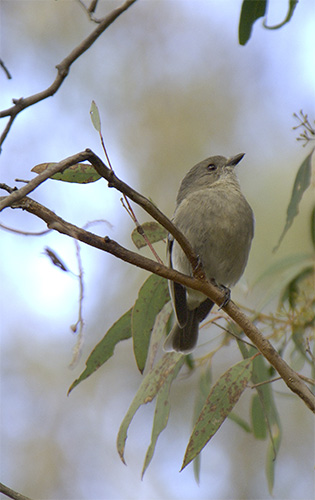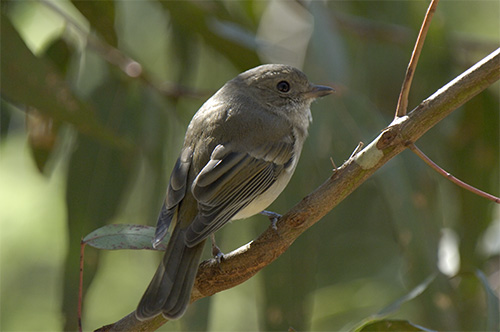Thanks Geoff (and all the others who offered suggestions),
The below could very well explain it. They were not the same bird, BTW.
Thanks again. 8^) It is great having access to a bunch of birding bods such as yourselves. 8^)
on 19/4/06 9:44 AM, Geoffrey Dabb at wrote:
James
The difficulty with this kind of question in relation to individual photographs is that colour and its particular texture – particularly ‘white’ or ‘not white’ - depends so much on the attitude of the bird and how the light is striking its feathers. I am not sure if the two below pictures are of the same bird, but if they are – and probably if they are not - I would attribute the apparent difference in the lightness of the belly area to that area being in shadow in the frontal picture and caught by the light in the profile picture, possibly being reflected light from the perch.
The best indicator of a ‘juvenile’ Golden Whistler is russet in the wing, but this is not evident in either of the below photographs.
It is true that field guide illustrations are often unsatisfactory on fine details. The HANZAB drawings are particularly poor on this point. For the local sub-species the ‘Directory’ says that females and russet-winged immatures have a ‘greyish white lower breast and belly, and white crissum [area around the vent]’. Of the photographic field guides, the Flegg and the Trounson both show this contrast between the darker upper breast and the pale lower-breast/belly, accentuated by overexposure in the latter case. The NPI ‘Robins and Flycatchers’ volume has better pictures, particularly on pp 208 and 210, the latter being of the Tasmanian subspecies, which according to the directory is similar in this respect. Geoffrey
From: James Rolevink
Sent: Wednesday, April 19, 2006 7:48 AM
To: Fergus Hornblower
Cc:
Subject: Re: [canberrabirds] No flames / scarlets at Tidbinbilla, but...
Each to their own. Believe it or not, I get satisfaction from taking the photos, then having a reason to engage with the group...
Also, the reason I ask is, the female whistlers I have photographed in the past do not seem to have white tummies. In my extremely limited experience, most seem to have grey tummies:

Moreover, I have yet to find a field guide that is so photographically accurate as to categorically prevent argument, even amongst our esteemed expert birding colleagues.
Is the white a feature of juvenile female Golden Whistlers?
on 19/4/06 7:18 AM, Fergus Hornblower at wrote:
James,
Have you tried getting out a field guide and having a look for yourself. Believe it or not that is why many of us get satisfaction from birding.
Fergus
James Rolevink <> wrote:
No flames / scarlets at Tidbinbilla, but... 
What is this one?
Cheers,
James
www.MacAttack.com.au
A web site dedicated to: • amateur photography • elegant computing solutions
James MM Rolevink, BCompSci, BArts | e-mail: | phone: (+612) / (02) 6249 6200 | mobile: 0411 800 204
"those who truly love computers also truly hate Microsoft" — Rebecca Eisenberg, Silence of the Lambs
http://www.sfgate.com/cgi-bin/article.cgi?file=/examiner/archive/1998/11/15/BUSINESS3152.dtl
|

